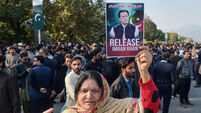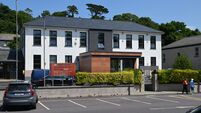Video chronicles bomber's last days
The camera shows the suicide-bomber warmly embracing a group of masked men.
There are kisses on the cheek and a shot of him in the cab of a truck – his fingers resting on what appears to be a detonator.
He reads a statement, telling his wife and his companions: ”I sacrifice myself for my religion.”
Then, as a camera films cars passing quietly across a bridge, an explosion sends up a massive ball of fire.
The scene, of the suicide-bomber’s mission, is one of several on a video given to Time Magazine correspondent Michael Ware by men reportedly in close contact with Jordanian-born terrorist Abu Musab Al-Zarqawi’s network.
The video chronicles what are supposedly the final days and hours of the militants as they ready themselves for suicide missions.
Superimposed on scenes of them praying and relaxing, are individual shots of the men reciting living wills, explaining why they are carrying out the attacks.
The tape does not say where the bridge attack occurred, but two others said to be shown are the June 14 attack on General Electric contractors in Baghdad and the May 17 suicide car bombing of a president of the now-defunct Governing Council.
Independent confirmation of the claims was not possible, but Al-Zarqawi’s Tawhid and Jihad group claimed responsibility for both those bombings, as well as the beheading of American businessman Nicholas Berg and South Korean translator Kim Sun-il.
Ware, who met the militants over the course of a year, said the video underscores the growing sophistication of the group and casts light on how it is working to recruit new followers in an increasingly competitive market for funding for such activities.
It also sends a message to coalition partners and foreigners working in Iraq that “We can get you. You cannot stop us,” he said.
The video “is a very, very sophisticated part of Zarqawi’s information campaign, stamping him as the star of the new global jihad inspired by Osama bin Laden”, said Ware.
In a prelude to the filming of the June 14 attack on the electricity sector contractors, which left 13 dead and 62 injured, the attacker explains: “The doors of hell have been opened to receive the infidels.”
In another shot, the car in which the cameraman is reportedly filming the May 17 suicide car bombing of Governing Council head Izzadine Saleem, is so close that the windscreen is cracked from the force of the explosion.
Saleem and eight others, including the bomber, were killed in the attack outside the Green Zone.
Both videos show routine street scenes interrupted by huge blasts.
“These are men that are prepared to die in a few days,” says Ware, commenting on footage of showing purported attackers resting and joking in a safe house before carrying out a suicide boat attack in April that targeted offshore oil terminals near the then British controlled southern city of Basra.
“It’s just fascinating to watch a face like that and know in a day or two, he’s dead. And he knows this is coming and he welcomes it,” he said.













